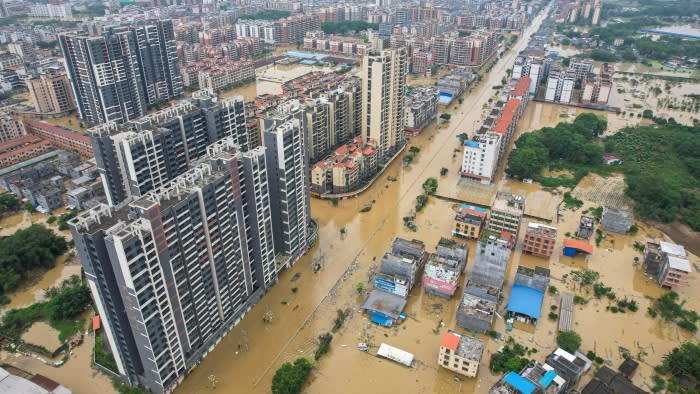Stay informed with free updates
Simply sign up to the Climate change myFT Digest — delivered directly to your inbox.
Intense heatwaves in India, Thailand and Bangladesh and fatal floods in China and Pakistan this week have coincided with the latest UN weather agency warning that climate change is causing major repercussions across Asia.
More than 100,000 people have been evacuated from Guangdong province in China in recent days as heavy rainfall led to flooding. Pakistan has also experienced heavier rainfall than usual in recent weeks, with officials warning of a heavy loss of life.
At the same time, in India temperatures are forecast to exceed 40C in many parts, while temperatures were already more than 40C in areas of Bangladesh, Thailand, Laos, Philippines, Myanmar and Indonesia. High humidity also causes the effect of the heat on the human body to be magnified.
The April heatwave comes after many countries in Asia also experienced their hottest year on record in 2023, a report from the World Meteorological Organization showed.
The combination of climate change and the naturally occurring El Niño weather pattern that warms the Pacific Ocean drove up temperatures and meant Asian countries were hit with a “barrage of extreme conditions, from droughts and heatwaves to floods and storms” in the past year.
“Climate change exacerbated the frequency and severity of such events, profoundly impacting societies, economies, and, most importantly, human lives and the environment that we live in,” said WMO secretary-general Celeste Saulo.
The government ordered some schools to be closed in Bangladesh this week because of the “severe heatwave” sweeping over the country, while in parts of India the school holidays have been brought forward because of the heat and expectations of temperatures reaching as high as 45C.
The Bangladesh Meteorological Department issued a notice on Tuesday to its population that an “increasing moisture incursion” — with humidity hitting 73 per cent in the capital of Dhaka — during the “prevailing heatwave” would make conditions highly uncomfortable.
The Philippine Atmospheric, Geophysical and Astronomical Services Administration has forecast that temperatures could reach as high as 52C over the country’s hot and dry season.
Asia was the world’s most disaster-hit region from weather, climate and water-related hazards last year, the WMO said. A total of 79 disasters caused more than 2,000 lost lives and a further 9mn were affected, mostly linked to flooding and storms.

The WMO report found the annual mean near-surface temperature over Asia in 2023 was the second highest on record, with particularly high temperatures from western Siberia to central Asia and from eastern China to Japan.
The report said the impact of heatwaves in the region was becoming more severe, although floods and storms continued to cause the highest number of reported casualties and economic losses in Asia.
Harjeet Singh, a New Delhi-based climate activist, said countries in Asia rapidly needed finance to adapt their economies and deal with damages caused by climate change.
“Developing countries in Asia bear the brunt of climate-related adversities without the adequate means to combat foreseeable disasters and the worsening impacts of climate change,” he added.
The WMO report found that in many parts of Asia, seas are warming three times faster than the globally averaged sea surface temperature.
Climate Capital

Where climate change meets business, markets and politics. Explore the FT’s coverage here.
Are you curious about the FT’s environmental sustainability commitments? Find out more about our science-based targets here


